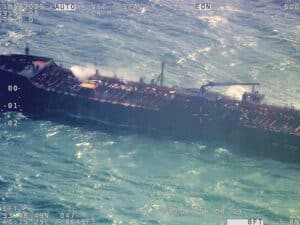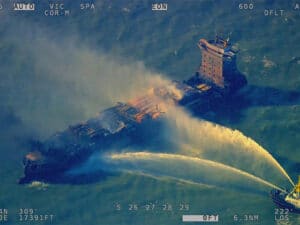
Grounded containership breaks in two
Written by Nick Blenkey Severe weather overnight has separated the MV Rena into two pieces, which are now about 20-30m apart on the Astrolabe Reef, Maritime New Zealand said in a statement issued 9.30 am local time, January 8. The Costamare-owned 3,032 TEU containership grounded on Astrolabe Reef off Tauranga, New Zealand, on October 5, 2011. The master and a second officer in charge of the navigational watch have been charged in the accident.
Severe weather overnight has separated the MV Rena into two pieces, which are now about 20-30m apart on the Astrolabe Reef, Maritime New Zealand said in a statement issued 9.30 am local time, January 8. The Costamare-owned 3,032 TEU containership grounded on Astrolabe Reef off Tauranga, New Zealand, on October 5, 2011. The master and a second officer in charge of the navigational watch have been charged in the accident.

Both sections of the vessel still remain on the reef, says Maritime New Zealand, with the forward section remaining firmly wedged, while the aft section has separated and moved clockwise (or to starboard) about 13 degrees, after the ship was hit by seas of over 7 m overnight, further worsening the damage it sustained following its grounding on the reef just over three months ago. The current bad weather is forecast to slowly ease over next 3 – 4 days.
MNZ Salvage Unit Manager David Billington said the fresh damage to the ship had resulted in the loss of a large number of containers and debris.
“While the two sections of the Rena currently remain on the reef, there’s no question the ship is badly damaged with the severe movement breaking off many of the hatch covers and releasing containers from the holds. Salvors are now working to assess the state of the vessel so that naval architects can undertake further calculations get gain a clearer picture of its ongoing stability.”
Mr. Billington said the vessel Go Canopus was currently connected to the aft section of the Rena and was continuing to monitor its status.
Container recovery company Braemear Howells had tugs en route to tag containers with buoys as it was currently too rough to tow or safely recover them, while vessels with trawl nets would also be sent out to collect debris once weather conditions improved.
Navigational warnings had also been issued to shipping, with the port company communicating with individual ships via port radio and warnings issued to recreational vessels via Coastguard radio. Shipping lanes were also being monitored for containers and debris. The Bay of Plenty Regional Council Harbour Master is considering extending the 3 nm exclusion zone due to the large debris field from Rena.
National On Scene Commander Alex van Wijngaarden said the National Response Team had been mobilized and included trained oil spill response and wildlife experts, who were preparing for the likelihood of more oil coming ashore.
“While reports at this stage indicate there has not been a significant release of oil, with the Rena in its current fragile state, a further release is likely,” he said. “While it is unknown at this stage exactly how much oil may be released, teams have been mobilized and will be ready to respond to anything that may come ashore. The wildlife response had also been increased to help deal with any affected wildlife.
“At this stage, preliminary trajectory modeling predicts that any oil released will come ashore around midnight tonight, landing on beaches south east of Mt Maunganui – however, this could change at any time depending on the weather and wind conditions. We also remind people that there may be large amounts of debris or containers that could come ashore so they need to exercise common sense and please keep clear.”
In a statement issued at 7.00 pm local time, Sunday, Maritime New Zealand said Communities along the Bay of Plenty coastline were being advised that container debris and oil from the wreck of the MV Rena is likely to begin coming ashore overnight and Monday, with a coordinated response ready to deal with whatever washes up, Maritime New Zealand (MNZ) says.
MNZ Salvage Unit Manager David Billington said while both sections of the Rena were still on the Astrolabe Reef, the stern section had moved an estimated 30 m from the bow section in seas of over 7 m overnight, after the stern pivoted about 13 degrees to starboard.
“While the two sections remain on the reef, both are now open to the sea and vulnerable to more damage. The stern section is also listing heavily at about 24 degrees and is heaving in current swells of about 4.5 m. The bow section is still firmly wedged in place on the reef, but it is open to flooding from the sea and is expected to deteriorate further in the rough conditions.”
MNZ Salvage Advisor Jon Walker said that there was a strong likelihood that the stern section would capsize and sink, which would make recovering any further containers from that section considerably more difficult.
Container recovery company Braemar Howells estimate that between 200 and 300 containers of the approximately 830 remaining on the Rena were lost overboard when the two sections of the ship separated, of which 30 had been identified, with 17 tagged with buoys. However due to poor visibility and the rough conditions around the Rena, it was difficult to gain a more accurate count.
Acting Operations Manager Claudene Sharp said that between 40 and 60 of the lost containers would likely be floating while the rest will have sunk. Those already located would be collected when the sea state improved. A vessel equipped with sonar was searching for other containers, and the priority was to ensure that the shipping lanes remained clear. Several different vessels, including tugs, barges and landing craft, were also available to recover the containers and debris as soon as conditions allowed.
Ms Sharp said current weather patterns were pushing containers in a westerly direction between Astrolabe Reef and Mayor Island, and warned that debris or damaged containers could come ashore along the Bay of Plenty coastline over the next 12-24 hours.
National On Scene Commander Alex van Wijngaarden said that the National Response Team had been mobilized to deal with any fresh oil released from the ship, and members of the National Oiled Wildlife Response team would be checking Mount Maunganui and Leisure Island for oiled birds overnight. Assets from the Royal New Zealand Navy would be used to help patrol the exclusion zone around Rena and help ensure harbor channels remained clear, he said.
Mr. van Wijngaarden said it was very unlikely that oil reported ashore Sunday was from the previous night’s break-up of the Rena because wind and tides had initially taken it offshore, and was thought to be old oil that had been remobilized due to the recent rough weather.
“Any oil coming ashore in the coming days is expected to be much less the amount that washed up after the Rena first went aground,” he said. “Current modeling suggests that beaches south east of Mt Maunganui are most likely to be affected by oil and debris, which includes milk powder and timber.”
Mr. van Wijngaarden said no Tauranga beaches had been closed, but local surf life savers today advised people to stay out of the water because of the debris and sea conditions.
“We reiterate the message that people need to exercise their common sense and not swim or surf where there is likely to be containers, debris or oil coming ashore,” he said. “Also we ask that people keep clear of any debris or oil, and report it to us so that our trained people can come and clean it up.”
At a press conference in Tauranga, Environment Minister Nick Smith said that the efforts of MNZ and the salvors over the last three months ensured that the impact of the Rena’s break-up was much less than would have been the case when the vessel first went aground. “The risk to the environment is a fragment of what it was, with at the most tens of tonnes of oil rather than hundreds of tonnes that potentially could be spilled.”
Mr. Smith said that the environmental risk from dangerous goods known to be on board Rena was small. There were originally 21 containers of cryolite from the Bluff aluminum smelter and many containers of milk powder. Both these substances would be well diluted by sea water, Mr. Smith said.
January 8, 2012





Leave a Reply
You must be logged in to post a comment.